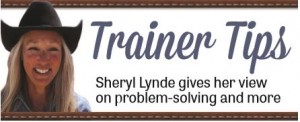 Years ago I was giving a clinic in mid-July, and I noticed that an owner would blanket her horse each night with a fairly thick blanket. A combination between the heat of summer and the weight of the blanket produced a pretty good sweat, so I asked the owner, “Why the blanket?”
Years ago I was giving a clinic in mid-July, and I noticed that an owner would blanket her horse each night with a fairly thick blanket. A combination between the heat of summer and the weight of the blanket produced a pretty good sweat, so I asked the owner, “Why the blanket?”
She explained that when she purchased her horse she had been informed that he was “cold-backed”. Hence, the blanket.
The term “cold-backed” is not a physical description. It’s just an analogy that indicates they need to be worked on the ground or warmed up prior to riding. In the same way, people can be regarded as being cold because of their inability to show emotion or empathy. Again, this is just a description to identify a particular characteristic.
Some horses are more claustrophobic than others and need time to adjust to the cinch or the feel of the saddle on their back. A rider attempting to mount a cold-backed horse without appropriate ground work before riding can promote unwanted behaviors like bucking or rearing.
The severity of the behavior varies with each horse’s degree of resentment to being saddled. The more severe the behavior, the less suited the horse is for a beginning level rider. They lack the feel and discernment needed to identify clear warning signs that, when worked through, can prevent the behavior from getting started.
An 8-year-old mare came to me with a bucking issue to resolve. The owner had been bucked off several times attempting to mount. Once she was seated in the saddle, the mare would take a step and explode. The bucking became more intense, and the mare could be set off by merely placing the owner’s foot in the stirrup. There were times the owner was able to ride out on trail successfully, but it was the climbing on that was proving to be most dangerous.
When the owner purchased the mare, she was instructed that she needed to be warmed up on the ground prior to riding. However, she was unaware of what the implications would be, and for the first month her mare exhibited no obvious signs of distress. Gradually, though, she became more and more anxious until the bucking presented itself.
I worked with her horse over a period of a couple of months. Because of a previous injury, her mare had not been ridden for a year, so I was also tasked with getting her in shape to ride again. She was ultra-sensitive to the cinch, so I took additional time cinching her up. If she was cinched too tightly, too fast, she’d throw her head up, her eyes would widen, and her body stiffened as she exploded into a bucking episode. Additionally, she was quite inflexible laterally, so I spent time getting her soft and giving to the bit by ground driving. She was extremely nervous when asked to bend laterally to the point of panicking, which also triggered a bucking scenario.
Her reactions were so extreme that I wanted to ensure pain was not the culprit. We checked her teeth and scoped her stomach for ulcers, and there were no problems there. This mare was truly claustrophobic, and even though she was eight years old, she was actually pretty green. I put her in a snaffle and continued to work on her flexibility from the ground, asking her to give to pressure, one rein at a time. Once she was calm and no longer bucking with cinching or ground driving, I began gradually getting on and off until she had a soft eye. Prior to mounting, I made sure I had her nose to the stirrup by taking the slack out of one rein. Once I was on her back and she was calm, I would dismount, move her feet a bit and repeat. I mounted on both sides until she was basically bored, standing quietly with her foot cocked.
I was able to continue with this mare and successfully ride her at a walk, trot and canter in the round pen where she was most nervous, then out on trail where she was most relaxed. By preparing her properly, I was able to safely ride and the bucking episodes disappeared.
Horses, like people, have varied personalities, and all exhibit their own distinct idiosyncrasies. Getting to identify their characteristics and understand how to work with them as well as set them up for success takes time, just like anyone close to you in your life.
The owner did everything the right way. She knew that she and her horse were headed down the wrong road, so she came for help. A good trainer will work with the horse and teach the rider specific ground work to prepare the horse safely for riding.
Sheryl
Leave a Comment
All fields must be filled in to leave a message.